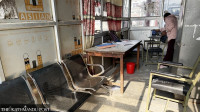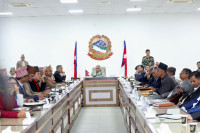National
Government decision to relax protocols on public buses draws criticism
Activists, doctors and local authorities say the move will only increase the risk of transmission of Covid-19 among the public.
Anup Ojha
At a time when Covid-19 cases are spiking in the Valley, the Cabinet on Monday decided to lift restrictions on public vehicles to ferry passengers to their full capacity.
The government's decision has been widely criticised by consumer rights groups, doctors and the mayors of municipalities in the Kathmandu Valley. Allowing public vehicles to carry passengers to their full capacity will make the situation grimmer in the coming days, they say.
“This is the biggest crime the government has committed against the general people, because the decision itself is made with a criminal mindset,”said Jyoti Baniya, president of Forum for Protection of Consumer Rights.
He said that until now, the members of the public have been blamed for spreading coronavirus. But now the government’s policies are helping the virus spread, said Baniya. “It’s because of the government that more people, mainly from the working class will suffer and may even die,” said Baniya.
The government last month allowed long-haul buses to resume operations, six months after they were ordered to stay off the road as part of efforts to contain the spread of the highly contagious coronavirus that has already killed a million people worldwide. Authorities had earlier said that buses would be allowed to ferry passengers equivalent to 50 percent of their seating capacity.
Even though passengers dreaded boarding public buses—many didn’t follow safety protocols set by the government—they continued to do so, worrying public health experts.
“But this new rule will make things more dangerous. It will become easier for the virus to get transmitted from one passenger to another, and ultimately reach villages through the going home to celebrate Dashain,” said Dr Sher Bahadur Pun, virologist at the Sukraraj Tropical and Infectious Disease Hospital, Teku.
In addition to that, around 50 percent of the people carrying the virus are asymptomatic. “ And the problem with Nepalis is they prefer to talk to strangers sitting next to them to pass their time. This increases the risk of transmission.”
Activist Baniya accused the government of playing into the hands of business people. “Because the government doesn’t decide with the people’s interest at the centre, It has been passing that favour of vehicle operators,” Baniya told the Post.
“For example, it hiked the bus fare by 50 percent even when the country was reeling under an economic crisis due to Covid-19 pandemic and six months of lockdown,” said Baniya.
The number of Covid-19 cases crossed 100,000 in Nepal last week with active cases soaring every day. According to the Ministry of Health and Population a total of 2,129 new cases of Covid-19 were reported in Kathmandu Valley on Tuesday.
The Kathmandu Valley Mayor Forum, a grouping of mayors of the Valley, has also criticised the government's move. “A month ago the mayor forum had requested the government to seal the Valley until Dasahin and deploy security personnel at different entry points, but it didn't listen to us,” said Madan Sundar Shrestha, Mayor of Madhyapur Thimi and secretary of the forum.
Transport operators, however, say that even though the government has relaxed rules of operation, people still won’t board their vehicles. “The government has never worked for the welfare of entrepreneurs, otherwise during the six months of lockdown it would have offered some relief package for transport labourers,” said Yogendra Karmacharya, chairman at the Federation of Nepalese National Transport Entrepreneurs.
He said Dashain was the only season for entrepreneurs to recover losses incurred during the six months of lockdown. But with the government telling people to stay home, the festive season looks grim, said Karmacharya. “Believe me, even people are not travelling these days. The government's decision does not make any sense, we were not in a mood to charge 50 percent extra bus fares anymore and the government reversed this decision,” said Karmacharya.
According to the Metropolitan Traffic Police Division, every day less than 20,000 people are leaving Kathmandu Valley ahead of Dashain. This is just a fraction of the numbers recorded during the pre-pandemic days.




 15.12°C Kathmandu
15.12°C Kathmandu.jpg)















